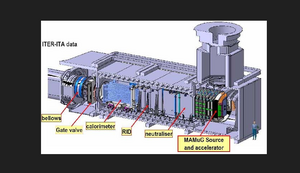Heating up the fusion fuel
What has been functioning in the sun from the beginning at just six million degrees Celsius requires great effort on Earth: To initiate nuclear fusion, the hydrogen plasma, the fusion fuel, must be heated to over 100 million °C. This is accomplished, for example, by injecting fast neutralized hydrogen particles into the plasma. The idea of this "Neutral Beam" is simple. "It is very similar to the steam injector of the household cappucino machine heating up the milk," the Plasma Scientist Jef Ongena from the German Research Facility in Jülich once described it. "It's all about the transfer of kinetic energy." But as usual, reality is not always as simple as theory. To enable the neutral particles to penetrate deep into the plasma, they have to be fast. In fact, as the ITER plasma is many times larger than in existing tokamaks, they have to be very fast!
In order to accelerate the hydrogen atoms to a kinetic energy of 1 mega electron volt, they first have to be made tangible to electric forces as charged particles — positive or negative ions. It has been exclusively positively charged particles that have been used up to now in the heating systems: electrons are removed from neutral hydrogen and the positive charged hydrogen ions are then accelerated by electric fields to the required energy. Before being injected into the fusion plasma, however, the ion beam must be neutralized because charged particles would be deflected by the magnetic field of the plasma cage: For this purpose the ions have to pass through a cell containing gas. Here the ions regain the missing electron from the gas and can be injected as fast neutrals into the plasma.
ITER now imposes new requirements on this proven method: for example, in the ITER machine, the particles have to be three to four times as fast as hitherto so that they can penetrate deep enough into the plasma. It is no longer possible to work with positively charged ions, as they are all the more difficult to neutralize the faster they are. At the velocities of 9000 kilometres per second needed for ITER, it is almost no longer possible.
For ITER, it is therefore necessary to change to negatively charged ions, which are easy to neutralize at high velocities. However, they are more difficult to create and to handle than positive ions: The additional electron, which is responsible for the negative charge of the particles, is only loosely bound and is accordingly readily lost.
The neutral beam system design for ITER consists at present of two Heating and Current Drive (H&CD) injectors and one Diagnostic Neutral Beam (DNB) injector. Each H&CD injector will deliver a deuterium beam of 16.5 MW (total 33 MW), with energy of 1MeV (in D-operation and 870 keV in H-operation and will be able to operate for long pulses up to 3000 seconds.
Two negative Ion-based injectors are currently operating in the world - on the JT60 Upgrade and the Large Helical Device (LHD), both in Japan. Compared to these systems, the Neutral Beam System required for ITER implies a major leap forward: Each H&CD injector will deliver a deuterium beam of 16.5 MW - which is a factor of four above the power output of the existing Negative Ion Sources - with an energy of 1MeV (compared to 350 keV in the currently operating devices). The biggest challenge, however, remains the required accelerating current of 40 Ampere. The acceleration currents reached in a test bed and in JT-60U so far were in the range between 0.02 A and 17.4 A.
Besides the quest to produce negative ions, operating at these high currents is constrained by the requirement of low divergence (0.03 degrees) and potential overheating of the acceleration grids. Therefore, a test facility is planned to be built in Padua to develop a prototype full 1 MV beam line.


